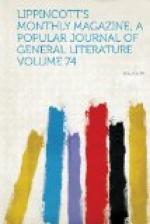It is a matter of certainty that Mary Stuart planted a tree fast by Cockhoolet Castle—she would not have been herself if she had not done that—and a magnificent tree it is, very old and quite big enough for its age. The queen must have been fond of planting trees, and, considering the number she planted, it is astonishing how she found time for so many less innocent employments: she must have improved each shining hour, and, poor woman! she had not too many of these.
There is a walk also, called the Lady’s Walk, leading away from the castle up a bosky dell, where a burn amuses itself playing at hide-and-seek, but, like a little child, betrays its hiding-places by its voice, and comes out into the light again and laughs at its own joke. Did the queen ever wander here? did she ever “paidle in the burn when summer days were fine”? did its murmur ever soothe her ear? did she ever see her fair face in its pools, or drop bitter tears to mingle and; flow on with its waters?
The burn has kept trotting through the dell for six thousand years, singing its song all the time, and its speed is as good and its voice as clear and musical as when the morning stars sang together and all the sons of God shouted for joy. Many a wild story it could tell if its murmur could be understood; but it is a murmur only—a murmur which crept into the ears of Caesar’s legions, of Queen Mary, of Bessie Ormiston, and will creep into yours, O reader! if you like to go and explore the Lady’s Walk, when you can interpret the murmur for yourself, as all your predecessors no doubt did. In days of old it fed the moat, traces of which are to be seen round the castle still, although it has long since been filled up and covered, like the park of which it forms part, with rich natural pasture, soft, thick and velvety. In short, Cockhoolet had everything that a castle ought to have, and wanted nothing that a castle ought not to want, not even a ghost.
It was not the ghost of Mary Stuart: that would have been too shocking—a ghost without a head, or having a head and a broad vivid ray of red encircling its neck. Such a ghost would have made every one who saw it lose his senses. Cockhoolet Castle had a ghost: so much was certain, but hitherto no one had ever either seen or heard it. How, then, was it certain? Why ask a question like that? Is it reasonable to pin a human being down to prove a ghost? Will not presumptive evidence do? Strange things had happened, must have happened, at the castle: is it for a moment to be supposed that these things had happened and all gone scot free?—in other words, that not one of them had left a ghost? It is not to be supposed.
II.
It was Christmas Day. Christmas Day is not solemnized and festivalized in Scotland as it is in England; still, the observance of it in some shape is creeping in more and more. It was Christmas, and Mr. and Mrs. Ormiston had gone to be present at a feast from which they were not expected to return till the following day. There were left at home the Rose, as head of the family for the time being; her sisters, Bell and Jessie, supposed to be little girls still, although the supposition made them very indignant; and her two brothers, John and William. A guest aad two servants made up the known inhabitants of the house.




